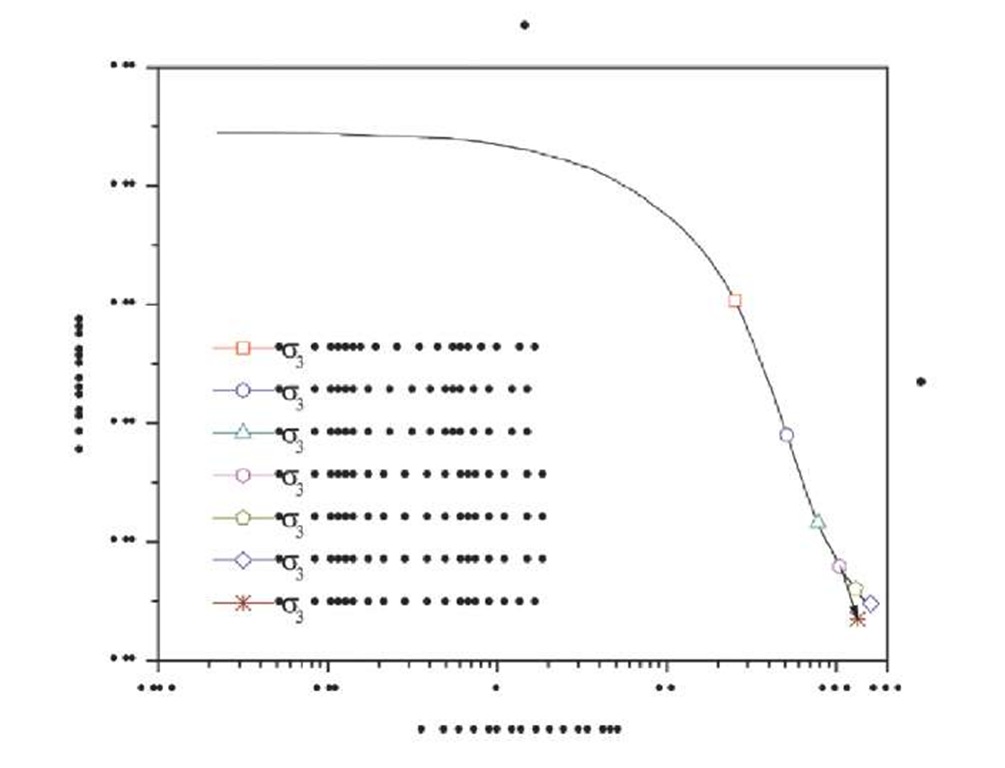ABSTRACT
Under intensive loading, either hydrostatic or dynamic shear, sand particles are broke up to smaller particles. In this study, we randomly embedded color-coated sand grains of five different initial sizes inside cylindrical sand specimens under dynamic tri-axial loading. The quasi-static pressure was varied from 25 to 150 MPa at 25 MPa intervals and then unloaded. The embedded particles were retrieved and found fractured particles increased with increasing pressure. However, many of the colored particles remained intact. Under 100-MPa hydrostatic pressure, additional axial load was added at three different strain rates, 0.01, 500, and 1000 s-1. It was found that, under additional dynamic loading nearly all the colored particles were fractured. In addition, to the attention on the embedded colored particles, the overall size change of the sand from the loaded specimens were also quantified.
INTRODUCTION
Particle fracture plays a major role in the mechanical behavior of sands. When sand particle breaks into a number of pieces, the total surface area of sand increases whereas the number of contacts per particle decreases. Particle size distribution of sand is, therefore, a key characteristic, which influences its properties, handling and domain of application. Loading rate on sand may vary significantly in applications. The quantity and type of particle breakage at high rates of loading may differ from that at low rates. However, there are very limited experimental results found in the high rate range, late alone particle breakage analysis. In our previous work we investigated the shear behavior of sand at high strain rates [1]. In this study, we investigate the effect of strain rate on sand particle breakage behavior. In addition, the effect of hydrostatic pressure was also investigated. All other factors were kept constant.
EXPERIMENTS AND RESULTS
In order to study the particle breakage in a sand specimen, five different size sand particles (particles retained on US sieve No. 30-50) were first color-coated with different colors. Twenty sand particles corresponding to each of the five different sizes were randomly dispersed in the specimen. The specimen was then subjected to either isotropic consolidation only or isotropic consolidation followed by triaxial shear. Figure 1 shows all the experimental conditions in terms of void ratio and mean pressure for this study. The isotropically consolidated specimens were taken to 6 different confining pressure levels ranging (as shown by different symbols in Figure 1) from 25 MPa to150 MPa at an interval of 25 MPa. On the other hand, triaxial shear experiments were conducted by first applying a hydrostatic pressure of 100 MPa, followed by axial loads that were applied at constant strain rates of 0.01, 500 and 1000 s-1 (as shown by the arrow in Figure 1).
After the loading, the specimens were carefully dismantled and spread on a bench from where the colored particles were removed. Presence and type of failure as well as presence of significant fracture surfaces were recorded for each of the colored particles using an electron microscope. Based on the damage observed, the colored sand particles were categorized into three groups. These are ‘Type 1′ if there was no visible damage, ‘Type 2′ if there was only surface abrasion of the particles leaving the parent particle largely intact but usually more rounded, and ‘Type 3′ if there was a major fracture of a particle into two or more pieces. Table 1 tabulates the results.
Figure 1: State paths for compression and shear experiments
Table 1: Particle Failure Observed for Isotropic Consolidation Experiments
|
Pressure Level (MPa) |
Grain size (sieve#) |
Grain damage |
|||
|
Type 1 (No damage) |
Type 2 (Attrition) |
Type 3 (Fracture) |
Lost |
||
|
30 |
17 |
1 |
2 |
||
|
35 |
10 |
7 |
3 |
||
|
50 |
40 |
9 |
7 |
4 |
|
|
45 |
7 |
9 |
4 |
||
|
50 |
7 |
8 |
5 |
||
|
30 |
8 |
9 |
3 |
||
|
35 |
7 |
12 |
3 |
||
|
100 |
40 |
7 |
7 |
5 |
1 |
|
45 |
6 |
7 |
7 |
||
|
50 |
5 |
6 |
8 |
2 |
|
|
30 |
7 |
8 |
5 |
||
|
35 |
6 |
7 |
7 |
||
|
150 |
40 |
4 |
6 |
8 |
2 |
|
45 |
3 |
8 |
9 |
||
|
50 |
2 |
4 |
11 |
3 |
|

